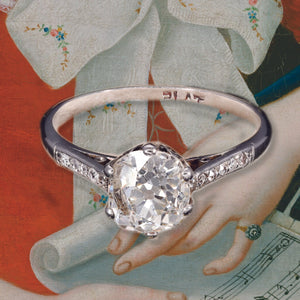The diamond solitaire engagement ring is one of the most enduring symbols of love and commitment — simple, elegant, and timeless. While today it’s seen as the classic engagement ring, its history reveals centuries of craftsmanship, symbolism, and evolving tastes. From Georgian gemstone settings to modern diamond brilliance, the solitaire’s story is as sparkling as the gem itself.
What Is a Solitaire Ring?
A solitaire ring features a single gemstone — usually a diamond — set prominently to maximise light and brilliance. The name comes from the French word solitaire, meaning “alone”, symbolising the idea that one person has captured your heart completely. It’s the ultimate statement of understated luxury, letting the stone itself take centre stage.
The First Solitaire Engagement Rings
The tradition of giving engagement rings began long before the modern diamond solitaire. In 1477, Archduke Maximilian of Austria proposed to Mary of Burgundy with a diamond ring — the first recorded example of its kind. The diamonds were set in the shape of an “M”, a bold and romantic gesture that set the tone for centuries of engagement ring design.
However, the solitaire as we know it — a single diamond in a raised setting — didn’t become widespread until the late 19th century, when new cutting techniques allowed stones to sparkle more brilliantly than ever before.
Victorian and Edwardian Solitaire Designs
In the Victorian era, solitaire rings often featured old mine-cut or old European-cut diamonds, set in yellow gold with delicate claws or collet settings. These designs reflected the romantic ideals of the age, often paired with ornate engraving or floral details.
By the Edwardian period, platinum became the metal of choice. Its strength allowed for finer settings that made the diamond appear to float above the band — a precursor to the modern claw-set solitaire we know today.
The Modern Solitaire and Tiffany’s Influence
In 1886, Tiffany & Co. revolutionised engagement ring design with their six-prong setting. This iconic design lifted the diamond above the band, allowing light to enter from all angles and creating unmatched brilliance. Known simply as the “Tiffany setting”, it quickly became the standard for solitaire engagement rings across the world.
This innovation transformed the solitaire from a simple design into a modern symbol of love and status — one that remains the foundation of countless engagement rings today.
Art Deco and Mid-Century Solitaire Styles
During the Art Deco period of the 1920s and 1930s, solitaire rings took on geometric influences. Diamonds were often set in bold, architectural settings, with baguette or calibre-cut side stones adding symmetry and sophistication.
By the mid-20th century, round brilliant-cut diamonds became the dominant choice. This cut, perfected by Marcel Tolkowsky in 1919, maximised fire and brilliance — the defining characteristic of modern solitaires.
Why Solitaire Rings Endure
The solitaire remains timeless because of its simplicity. Its single-stone design focuses on purity, commitment, and enduring love — qualities that never go out of fashion. Antique and vintage solitaires, however, add another layer of charm: a tangible link to history. Each one reflects the craftsmanship of its era, from hand-cut stones to traditional settings no longer made today.
Choosing an Antique Solitaire Engagement Ring
Whether you prefer the bold geometry of an Art Deco piece, the ornate gold of a Victorian design, or the clean elegance of a mid-century classic, an antique solitaire ring offers timeless beauty and individuality. Unlike modern mass-produced designs, each antique solitaire carries a story — a legacy of love that continues with you.
Explore our curated collection of antique and vintage rings to find a solitaire that stands the test of time — a perfect blend of history, craftsmanship, and romance.


